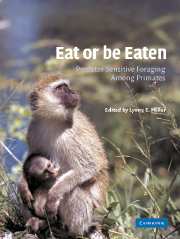Book contents
- Frontmatter
- Contents
- List of contributors
- Preface
- 1 An introduction to predator sensitive foraging
- PART I BIOLOGICAL VARIABLES
- PART II SOCIAL VARIABLES
- PART III ENVIRONMENTAL VARIABLES
- 12 Foraging female baboons exhibit similar patterns of antipredator vigilance across two populations
- 13 Foraging and safety in adult female blue monkeys in the Kakamega Forest, Kenya
- 14 Predicting predation risk for foraging, arboreal monkeys
- 15 Predator sensitive foraging in ateline primates
- 16 Antipredatory behavior in gibbons (Hylobates lar, Khao Yai/Thailand)
- Index
13 - Foraging and safety in adult female blue monkeys in the Kakamega Forest, Kenya
Published online by Cambridge University Press: 10 November 2009
- Frontmatter
- Contents
- List of contributors
- Preface
- 1 An introduction to predator sensitive foraging
- PART I BIOLOGICAL VARIABLES
- PART II SOCIAL VARIABLES
- PART III ENVIRONMENTAL VARIABLES
- 12 Foraging female baboons exhibit similar patterns of antipredator vigilance across two populations
- 13 Foraging and safety in adult female blue monkeys in the Kakamega Forest, Kenya
- 14 Predicting predation risk for foraging, arboreal monkeys
- 15 Predator sensitive foraging in ateline primates
- 16 Antipredatory behavior in gibbons (Hylobates lar, Khao Yai/Thailand)
- Index
Summary
Introduction
Finding food and avoiding being someone else's food are two problems every primate must solve. The trick is finding a solution to each problem which does not simultaneously compound the other one. For example, being in close proximity to conspecifics, who can reduce the chances of being preyed upon in various ways, may also lead to increased competition for resources. Feeding on the newly emerged leaves of a deciduous tree, a relatively easily harvested source of protein, may mean forsaking protective cover. Understanding how animals balance the sometimes conflicting demands of efficiency and safety in food acquisition can help us clarify their biological priorities. Comparisons of the various solutions across taxa can help us determine the extent to which behavioral solutions are phylogenetically canalized, or flexible responses to local environmental conditions.
This chapter considers the relations between foraging and antipredator strategies in an African forest guenon, the blue monkey (Cercopithecus mitis stuhlmanni). Blue monkeys are omnivores whose major dietary constituents are fruits, leafy matter (including leaf blades, petioles and buds), and invertebrates. They also eat flowers, nectar, gum, seeds, galls, and fungi. They harvest their foods from a broad array of plant species. For example, Cords (1986) reported that blue monkeys at Kakamega used at least 104 plant species as sources of plant food over a 12-month period, and at least 80 plant species (many of which did not double as sources of plant parts) as sources of invertebrates. In addition, blue monkeys show considerable variation in diet over various spatial and temporal scales.
- Type
- Chapter
- Information
- Eat or be EatenPredator Sensitive Foraging Among Primates, pp. 205 - 221Publisher: Cambridge University PressPrint publication year: 2002
- 12
- Cited by



